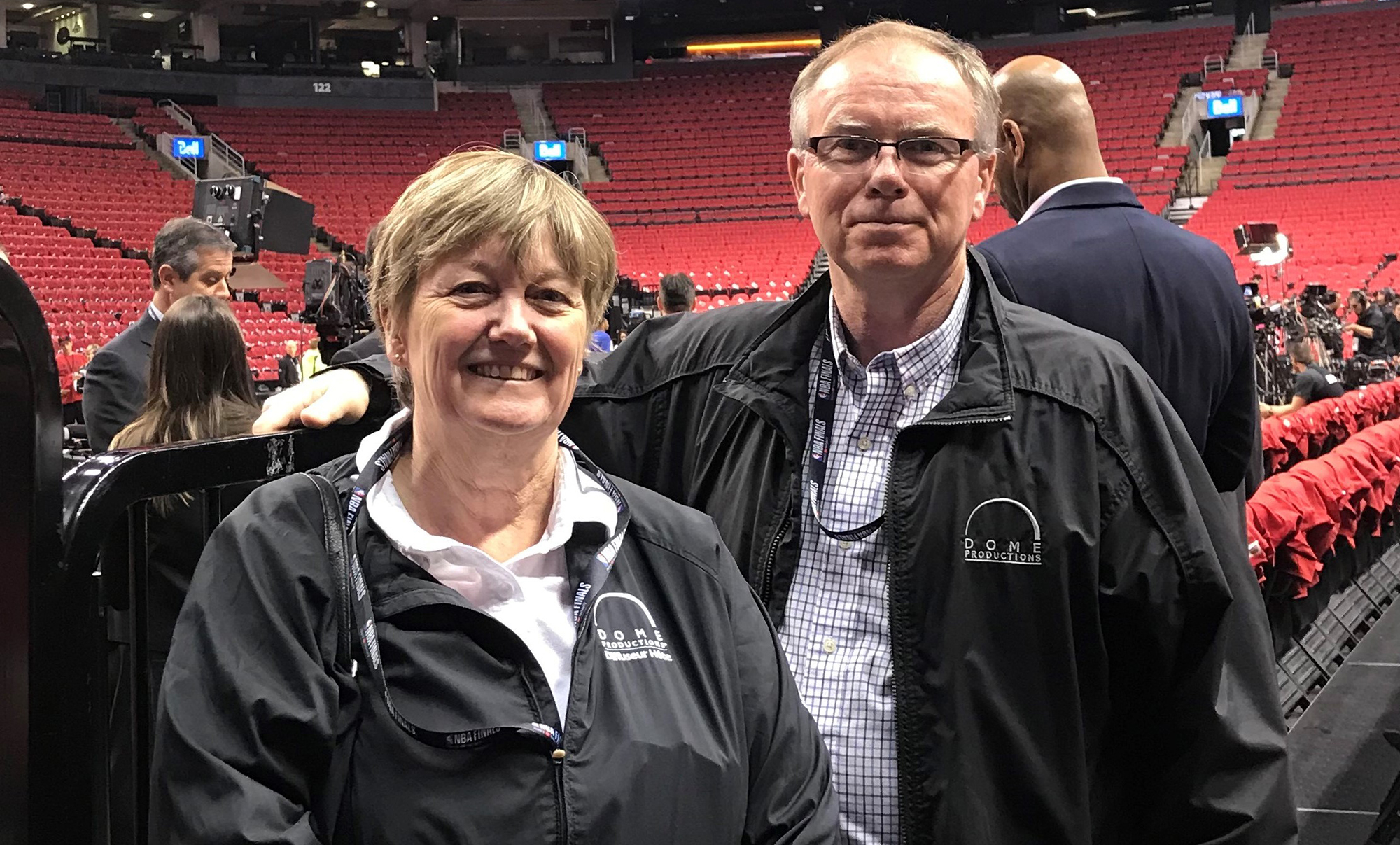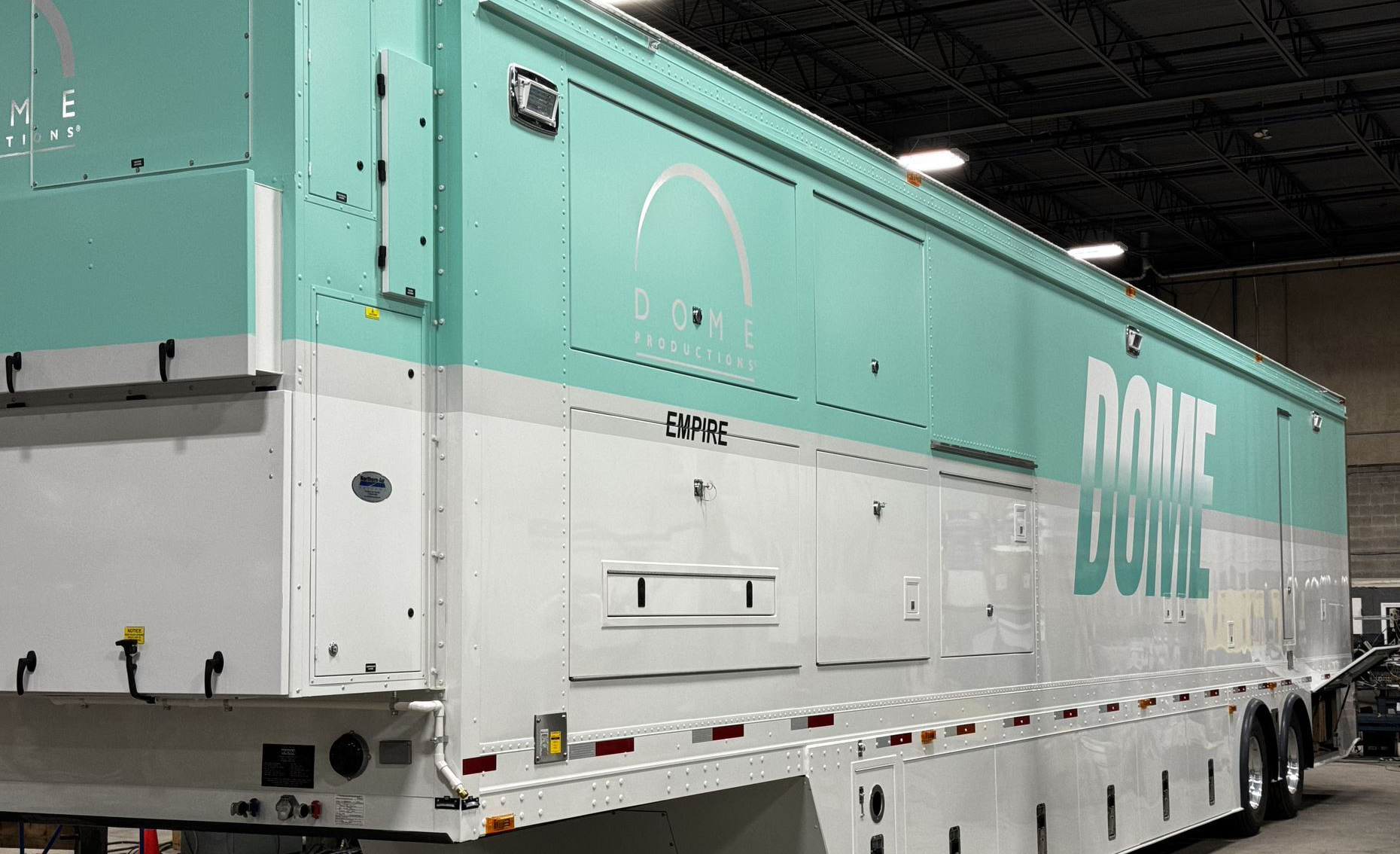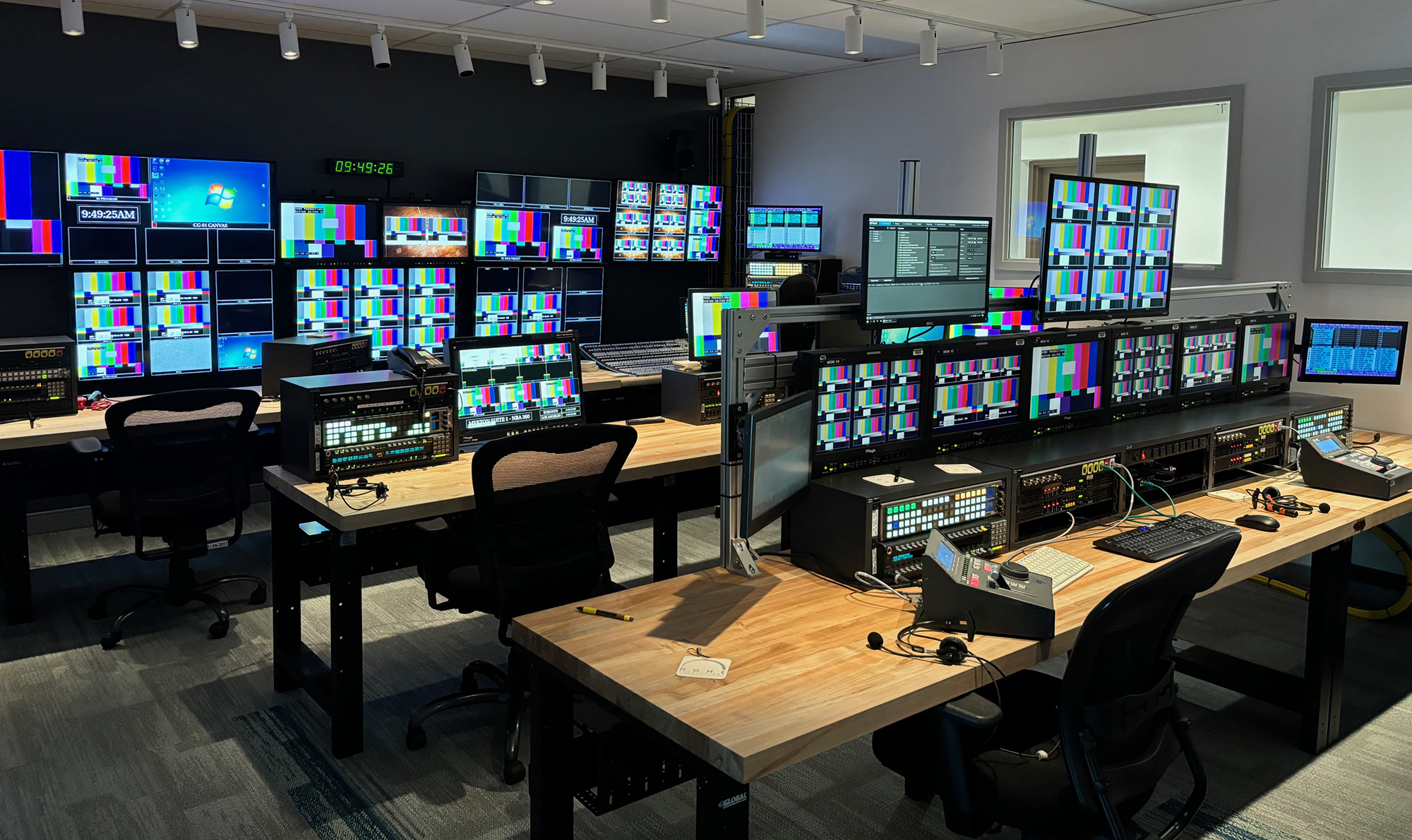SVG Sit-Down: Dome Productions’ Mary Ellen Carlyle and Mike Johnson on New 1080p HDR Trucks, the Promise of the Cloud, What’s Ahead in 2024
The Canadian facilities/distribution provider has opened a new facility in Toronto
Story Highlights
2023 was a busy year for Dome Productions, which exited its longtime home at the Rogers Centre for a new facility in midtown Toronto and built a pair of state-of-the-art IP-based mobile units, Titan and Empire. In addition, the company’s facilities and distribution services were as busy as ever, while its production services continued to add clients.
SVG sat down with Dome Productions GM/SVP Mary Ellen Carlyle and Director, Engineering, Mike Johnson to discuss the duo of new IP-based mobile units, the maturation of the IP production ecosystem, the 1080p-vs.-4K debate, the evolution of the company’s REMI business, the growth of the company’s Productions Services division, the rise of alternate broadcasts, the evolving role of the cloud, and what’s on Dome’s 2024 calendar.

Dome Productions GM/SVP Mary Ellen Carlyle and Director of Engineering Mike Johnson
Besides opening the new facility, you rolled out two brand-new IP mobile units in 2023. Why the aggressive truck-building year for Dome?
Carlyle: To be honest, COVID set us back a bit in terms of building trucks, so we needed to catch up. We ended up building two trucks [in 2023]. The last time we built back-to-back trucks like this was the 2010 Vancouver Olympics, so this was a pretty special year.
Johnson: We got Titan on the road at the beginning of August and Empire on the road at the end of December. They are nearly identical 1080p HDR trucks with a lift-up path to get to 4K. Our shows are only getting bigger, so they have a lot of capacity and the capability to add new services.
Both are all IP from the core, which is an Evertz NATX system, and are Evertz throughout all the frame syncs and other IP devices. We like that because of the interoperability it offers. It gives us better assurance that everything is talking to everything else, instead of having a lot of different vendors involved. Both trucks started taking shows right away, so we didn’t have any pause in terms of coverage.
[Both have] all Sony cameras and Canon lenses, EVS and Evertz DreamCatcher [replay], Grass Valley K-frame XP switcher — all the latest and greatest [equipment].
In your view, has the IP production ecosystem achieved full maturity? Will all future Dome trucks be IP?
Carlyle: We did our first IP truck in 2019, and we continue to improve our skills and awareness on that front. I think our engineers are well-versed in IP at this point, and we feel comfortable working with IP.
Mike tells the group this all the time in terms of the engineering: We aren’t going to go backwards. We’re going to stay IP going forward because it’s the right thing to do, but, in terms of operations, we don’t really need to be IP: you don’t get to charge more for it, and it doesn’t mean anything to the operators. But we’re not moving backwards. We’re going to continue to build IP trucks and continue to train our engineers. Even on the distribution side, it’s not going backwards. We see our future being IP.
Johnson: SDI was a robust environment: you could suffer some different problems and get a resolution very quickly. [With] IP, a problem can manifest itself in so many ways; there’s uncertainty about where the problem is originating from. But we’re figuring that all out. It’s part of the learning process; we work with our partners and when we learn something new, we know one more thing to avoid [in the future].
IP is not a technology that’s causing us to replace trucks. It’s not like anybody comes screaming to us, “Hey, I got to have your IP truck. If it’s SDI, I don’t want to see it.” We still have a lot of HD SDI trucks. We’re keeping those trucks running a bit longer, and I think you’ll see SDI for a long time to come.

Empire was one of two new Dome Productions Mobile units to hit the road in 2023.
Both of your new trucks are 1080p HDR. Where is 4K on your roadmap?
Johnson: Right now, we’re not seeing a lot of [requests] for 4K because it really cuts down on the volume of cameras and technology you can have on a show. As our shows keep growing, it makes more sense to stay in 1080p and upconvert to 4K toward the end [of the production chain]. That helps make it more economical and feasible when you want to deliver lots of camera angles and replay [channels] and things like that. IP supports that [workflow] because of the single-link capability. It’s what will allow you to deliver that 12-gig or 1080p signal.
Carlyle: We were on the 4K path all the way back in 2016 when we did 4K using the quad-3G [production model]. At this point, the switchers are there for 4K, the cameras are there, the EVS [replay systems] are there, but it’s hard to match the ease of operation that you get with 1080p HDR upconverted [to 4K]. The industry is moving in the direction [of 1080p], and we are always going to give the client whatever flavor they want. If the client wants native 4K, we can do native 4K. If they want to go 1080p upconvert, we can do that. But we certainly see a trend more toward 1080p upconverted to 4K.
How has the REMI portion of your business evolved over the past year?
Carlyle: It’s certainly part of our business, but I have not seen any major growth in REMI. Right now, 100% [of our] trucks can do REMI if needed. Let’s put it this way: before COVID, I had many REMI events, and today I have the same amount. It’s all about the flavor of the day: if you want to do onsite, we’re there for you; if you want a REMI [production], we’re there for that, too.
You’ve also put a lot of focus on your Productions Services division. How is that part of the business evolving?
Carlyle: End-to-end production services is something that we jumped into about three years ago and it’s only growing. We’re now doing NLL [National Lacrosse League], CEBL [Canadian Elite Basketball League], the PWHL [Professional Women’s Hockey League], the Toronto Arrow, and others. It’s something that we believe in, and I think we’re going to see it get even bigger in the [years ahead].
Dome made a big push into esports. How has the market correction in that part of the industry affected the company?
Carlyle: I think esports is still maturing. There are still going to be plenty of esports shows, but I don’t think you’re going to see the [same level of] business that we saw in the last five years.
Esports has been great to experiment [with] and explore because that [community] is a lot more open to innovative ideas and different workflows: working in the cloud, for example. In other areas we service, there’s just not that patience to go through the growing pains that come with that. So that has been very exciting and, I think, a great learning experience for everyone — both inside and outside of esports.
With esports on the downswing, what markets do you see as possible growth verticals?
Carlyle: We see the tier of sports that aren’t on linear broadcast starting to rise. We’re starting to focus on those smaller sports. I’d love to do pickleball, for example. It’s a small sport right now, but it’s going to become linear TV. I think you’re going to see a lot of that: you [will have a series of] smaller streaming productions, and then there will be a Game of the Week on linear TV.
Overall, there is more business than ever today — whether it’s the really big NFL and college-football shows, the national and regional networks here in Canada, or the smaller [leagues like the] NLL and the PWHL. [The smaller leagues is] the [market] we are seeing a lot of growth in.
Lately, are you seeing more requests for facilities to serve alternative broadcasts produced alongside the primary feed?
Carlyle: We haven’t seen that in Canada much yet, but we have been involved in it with some of our U.S. partners. That is a big reason we’re moving to 100-Gbps [fiber transmission] at our new facility. The bandwidth allows you to do a lot more with [alternative broadcasts], and we expect to be doing some testing soon.
Alternative broadcasts are definitely growing. For us, I think, it’s just going to mean extra facilities; it’s not necessarily going to be a whole new business. It means bigger shows but no additional setup time, so that will be a challenge. You’re going to see a lot more REMI and things like that for these alternative broadcasts and we will be ready to serve those clients when the time comes.

Is there a specific technology (or technologies) that clients are demanding more these days?
Johnson: I think the cloud definitely has a lot to offer. We will likely see more of a combination of cloud and on-prem to service REMI and REMCO productions. There are a lot of advantages there if you can get the connectivity.
And then, on the more top-flight programming, everyone wants as many high-frame-rate cameras as possible on a show. Today, you can certainly buy into those cameras based on a certain quantity of work, but you can also apply that [capability] as a short-term license for just a weekend rental. We appreciate that the manufacturers are heading in that direction and offering that kind of accessibility.
The other thing I would mention is AR graphics and compositing. That has been hugely successful for the NHL and the DED [digital-enhanced dasher boards] system and has become a lasting product. I think we’re going to see a lot more of that.
Carlyle: Our connectivity is going to benefit us [in terms of] the cloud, and we’re working on that right now. We are doing simultaneous tests right now: one as a REMI [production] and one in the cloud just trying to figure out what works best.
That’s where I see the alternative broadcasts coming into play; it’s a lot cheaper to put that [production] in the cloud than to bring a whole mobile unit onsite. We’re testing various cloud-based systems for that right now. The trials have been fun because it has been a learning opportunity for us and for our clients.
As today’s workforce ages, how are you finding your next generation of technicians and production crew?
Carlyle: That has been very interesting and challenging for us. The schools here want to be involved with Dome, so we have set up internships and hired several [students]. Unfortunately, to be honest, it’s very hard to get this generation to work weekends or travel. That said, we have found some great young people. You have to persevere and get them excited about what they’re doing. I would say about one in five young people has the passion to do this, and it’s our job to find them.
Engineering-wise, we’re in great shape. We started the engineering apprentice program a few years back, where three apprentices work in the maintenance area. They’ll move out, and we’ll bring three more in so we’re always developing new people. That’s going to be a big thing because people are retiring in our area and we need to find that next generation.
What else is ahead for Dome that you’re excited about?
Carlyle: We have a big project on the distribution side that will take advantage of our 100-Gbps–service capability. And refurbishing trucks will be big for us this year, but no new trucks are planned. We are looking at revitalizing the trucks that have been on the road for a while. We will talk about the next truck in 2025, and, hopefully, that will get us set up for 2026, when we look forward to the FIFA World Cup coming to North America. Obviously, that is going to be a big year not only for us but for the entire industry.
